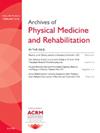Evaluation of Inadequate Response to Ultrasound-Guided Subacromial Corticosteroid Injection in Shoulder Impingement Syndrome: Treatment Failure or Central Sensitization?
IF 3.7
2区 医学
Q1 REHABILITATION
Archives of physical medicine and rehabilitation
Pub Date : 2025-08-01
DOI:10.1016/j.apmr.2025.01.469
引用次数: 0
Abstract
Objective
To evaluate whether central sensitization (CS), pain catastrophizing, and psychological factors are associated with inadequate response to ultrasound-guided subacromial corticosteroid injection in patients with chronic shoulder impingement syndrome.
Design
This study was designed as a prospective observational study, combining analytical cross-sectional and prospective elements to evaluate associations and treatment responses.
Setting
Secondary care outpatient clinic.
Participants
A total of 72 patients aged 18-75 years with shoulder impingement syndrome and at least 6 months of shoulder pain, planned to undergo ultrasound-guided subacromial corticosteroid injection, were included in the study.
Interventions
Not applicable.
Main Outcome Measure(s)
Treatment response was defined as a ≥50% reduction in pain (visual analog scale [VAS]) at 4 weeks postinjection. The presence of CS was assessed using the Central Sensitization Inventory (CSI) and pressure pain threshold via algometry (ipsilateral deltoid, contralateral deltoid, and contralateral vastus lateralis). Negative thoughts related to pain were evaluated with the pain catastrophizing scale, and mood status was assessed using the Hospital Anxiety and Depression Scale (HADS).
Results
Forty-eight patients (responders) experienced ≥50% VAS reduction, whereas 24 (nonresponders) did not. Nonresponders had significantly higher CSI (P=.000), HADS depression (P=.001), and HADS anxiety (P=.000) scores. The pressure pain threshold values were significantly lower in nonresponders at ipsilateral deltoid (P=.030), contralateral deltoid (P=.045), and contralateral vastus lateralis (P=.036). The CSI was significantly correlated with pressure pain threshold at ipsilateral deltoid (r=-0.400, P=.001), contralateral deltoid (r=-0.354, P=.002), and contralateral vastus lateralis (r=-0.442, P=.000); pain catastrophizing scale total score (r=0.449, P=.000); HADS depression score (r=0.572, P=.000); and HADS anxiety score (r=0.618, P=.000). CSI was the most predictive factor for nonresponse area under the curve (AUC=0.755, 95% confidence interval [CI]: 0.635-0.875). Multivariate analysis identified CSI as an independent predictor (P=.022), with a predictive accuracy of 72.2%.
Conclusions
Inadequate response to subacromial corticosteroid injection in chronic shoulder impingement syndrome is strongly associated with CS, psychological distress, and altered pain perception. Integrating CS-targeted interventions into treatment strategies may improve outcomes.
超声引导下肩峰下皮质类固醇注射治疗肩撞击综合征反应不足的评价:治疗失败还是中枢致敏?注射反应中的中枢致敏。
目的:评价慢性肩撞击综合征(SIS)患者超声引导下肩峰下皮质类固醇注射(SCI)反应不足是否与中枢致敏(CS)、疼痛灾难化和心理因素有关。设计:本研究设计为一项前瞻性观察性研究,结合分析性横断面和前瞻性因素来评估相关性和治疗反应。单位:二级保健门诊。参与者:共有72例18-75岁的SIS患者,肩部疼痛至少6个月,计划接受超声引导下的脊髓损伤。干预措施:不适用。主要结局指标:治疗反应定义为注射后4周疼痛(VAS)减轻≥50%。通过测量(同侧三角肌、对侧三角肌和对侧股外侧肌),使用中枢致敏量表(CSI)和压力疼痛阈值(PPT)评估中枢致敏的存在。采用疼痛灾难化量表(PCS)评估与疼痛相关的消极思想,采用医院焦虑抑郁量表(HADS)评估情绪状态。结果:48例(有反应者)VAS降低≥50%,24例(无反应者)VAS降低≥50%。无应答者的CSI (p=0.000)、hads -抑郁(p=0.001)和hads -焦虑(p=0.000)得分显著较高。无应答者的PPT值在同侧三角肌(p=0.030)、对侧三角肌(p=0.045)和对侧股外侧肌(p=0.036)显著降低。CSI与同侧三角肌PPT (r=-0.400, p=0.001)、对侧三角肌PPT (r=-0.354, p=0.002)、对侧股外侧肌PPT (r=-0.442, p=0.000)显著相关;PCS总分(r=0.449, p=0.000);hads -抑郁评分(r=0.572, p=0.000);hads -焦虑评分(r=0.618, p=0.000)。CSI是无反应的最预测因素(AUC=0.755, 95% CI: 0.635-0.875)。多变量分析确定CSI为独立预测因子(p=0.022),预测准确率为72.2%。结论:慢性SIS患者对脊髓损伤反应不足与CS、心理困扰和痛觉改变密切相关。将针对cs的干预措施纳入治疗策略可能会改善结果。
本文章由计算机程序翻译,如有差异,请以英文原文为准。
求助全文
约1分钟内获得全文
求助全文
来源期刊
CiteScore
6.20
自引率
4.70%
发文量
495
审稿时长
38 days
期刊介绍:
The Archives of Physical Medicine and Rehabilitation publishes original, peer-reviewed research and clinical reports on important trends and developments in physical medicine and rehabilitation and related fields. This international journal brings researchers and clinicians authoritative information on the therapeutic utilization of physical, behavioral and pharmaceutical agents in providing comprehensive care for individuals with chronic illness and disabilities.
Archives began publication in 1920, publishes monthly, and is the official journal of the American Congress of Rehabilitation Medicine. Its papers are cited more often than any other rehabilitation journal.

 求助内容:
求助内容: 应助结果提醒方式:
应助结果提醒方式:


